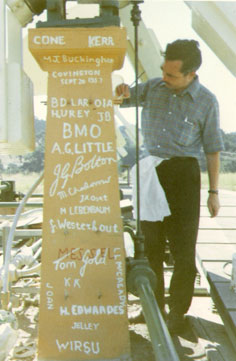
Ronald N. Bracewell touching up names incised by astronomers in a pier of one of the antennas in the spectroheliograph (Photo courtesy Bob Lash).

Ronald N. Bracewell touching up names incised by astronomers in a pier of one of the antennas in the spectroheliograph (Photo courtesy Bob Lash).
We are pleased to announce that the family of Ronald N. Bracewell (1921-2007) is donating Bracewell's radio astronomy papers to the NRAO Archives. The extensive collection, to be received over the next six to eight months, will include correspondence, technical reports, publications and manuscripts, photographs and moving images, and subject files.
Bracewell was born in Sydney in 1921. He received a B.Sc. in mathematics and physics from University of Sydney in 1941 then worked under Joseph L. Pawsey and Edward G. Bowen on development of microwave radar at the Radiophysics Laboratory of the Council for Scientific and Industrial Research. After World War II he received his PhD in physics from Cambridge University, then returned to the Radiophysics Laboratory where he focused on long wave propagation and radio astronomy. At Otto Struve's invitation, he lectured on radio astronomy in 1954-1955 at University of California - Berkeley, and he joined the Stanford University Electrical Engineering faculty in 1955. He retired in 1979, but continued active until his death.
At Stanford, Bracewell constructed a 32-dish microwave spectroheliograph in 1961 that automatically produced daily temperature maps of the sun for eleven years (one solar cycle). A second major radio telescope, an interferometer of five 60-ft dishes, was designed and built in 1971 to conduct solar and galactic studies.
In 1955, Pawsey and Bracewell co-authored “Radio Astronomy,” the first textbook in the field. Bracewell's “Fourier Transform and Its Applications” was published in three editions and translated into tens of languages. His interest in astronomical imaging led to his involvement in the development of computer-assisted X-ray tomography; Bracewell was on the founding editorial board of Journal of Computer-Assisted Tomography, lectured regularly on imaging, and in 1995 published “Two-Dimensional Imaging.” Bracewell's interests covered a broad range of topics outside astronomy and imaging: in 2005, e.g., the Stanford Historical Society published his book on “Trees of Stanford and Environs.”
Bracewell's radio astronomy papers will be an important addition to the NRAO Archives, and we are grateful to the Bracewell family for donating this significant collection.